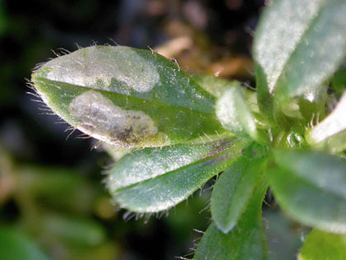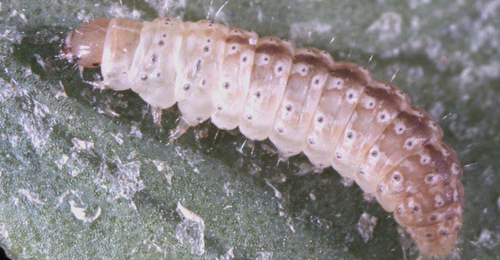|
||||||
|
SUAEDA. Seablites. [Chenopodiaceae] |
|
Three species of Suaeda are recorded in Britain. These include the native Annual Sea-blite (S. maritima) and Shrubby Sea-blite (S. vera). Eleven British miners are recorded on Suaeda. The coleophorid Coleophora atriplicis is recorded as a seed-feeder on Suaeda. A key to the European miners recorded on Suaeda is provided in Bladmineerders van Europa. |
Key for the identification of the known mines of British |
Note: Diptera larvae may live in a corridor mine, a corridor-blotch mine, or a blotch mine, but never in a case, a rolled or folded leaf, a tentiform mine or sandwiched between two more or less circular leaf sections in later instars. Pupation never in a cocoon. All mining Diptera larvae are leg-less maggots without a head capsule (see examples). They never have thoracic or abdominal legs. They do not have chewing mouthparts, although they do have a characteristic cephalo-pharyngeal skeleton (see examples), usually visible internally through the body wall. The larvae lie on their sides within the mine and use their pick-like mouthparts to feed on plant tissue. In some corridor miners frass may lie in two rows on alternate sides of the mine. In order to vacate the mine the fully grown larva cuts an exit slit, which is usually semi-circular (see Liriomyza huidobrensis video). The pupa is formed within the hardened last larval skin or puparium and as a result sheaths enclosing head appendages, wings and legs are not visible externally (see examples). See Key to non-Diptera. |
1a > Leaf and stem miner: Apart from mining leaves the stems are excavated. Oviposition takes place on the tips of shoots. The larva at first mines strip-like full depth corridors in the apical leaves, going then into the stem, which it hollows out, so that it becomes translucent. It then searches out leaves further down in which initially it mines depositing frass in strips, but then in blotches. The corridors often lie in one half of the leaf and can be branched. In the blotches the frass is irregularly scattered. Pupation is in the hollow stem or in the ground. |
|
Delia echinata (Seguy, 1923) [Diptera: Anthomyiidae]. |
1b > Leaf-miner |
2a > Leaf-miner: A white linear-blotch mine, the linear section sometimes not detectable as it becomes enveloped in later blotch (Spencer, 1976: 162). Puparium reddish brown |
|
Amauromyza flavifrons (Meigen, 1830) [Diptera: Agromyzidae]. |
2b > Leaf-miner: Blotch mines, generally occupying an entire leaf, usually containing several larvae. Much, half deliquescent, green frass. Mine indistinguishable from P. exilis or P. hyoscyami. |
|
Pegomya betae (Curtis, 1847) [Diptera: Anthomyiidae]. |
2c > Leaf-miner: Large blotch mine, often with several larvae, beginning with a short deeper corridor at a single egg shell on the surface of the leaf. The broad deep corridor later ends in a blotch but can be recognised (beneath the blotch) by its greater depth. Mine predominantly dorsal or ventral, greenish in transmitted light. Frass grains irregularly scattered except in the initial corridor. Blotch, mostly occupying almos the entire leaf, containing several larvae. Much, half-deliquescent, greenish-black frass. At the start of the mine at the leaf underside a group of some 5 elliptic egg shells, parallel to each other. However, the larvae can leave their mine and restart elsewhere, so mines without egg shells can occur as well. The larvae do not penetrate into the stem of the plant, neither is the mine full depth (compare Delia species). Mine indistinguishable from P. exilis or P. hyoscyami. Makes a large upper surface whitish blotch, which can contain several larvae. The frass has a washed out appearance and is greenish. There may be several mines on a leaf and eventually the leaf will be mined and then shrivel up. To identify this miner adults must be reared. |
|
Pegomya hyoscyami (Panzer, 1809) [Diptera: Anthomyiidae]. |
2d > Leaf-miner: Blotch. |
|
Botanophila depressa (Stein, 1907) [Diptera: Anthomyiidae]. |
2e > Leaf-miner: The mine starts as a long, narrow, winding corridor running towards the midrib, widening to a blotch. Usually upper-surface, but in small leaves also full-depth parts may occur. The blotch has broad lobes; in their ends most frass is accumulated in the form of green patches or clouds. Sometimes several larvae share mine. Pupation usually in the soil, less often in the leaf (and then generally not in the mine itself but in a small separated mine, that may even be made in the petiole). |
 Mine of Scaptomyza graminum on Cerastium glomeratum Image: © Jean-Yves Baugnée (Bladmineerders van Europaa) |
|
Scaptomyza graminum (Fallén, 1823) [Diptera: Drosophilidae]. |
2f > Leaf-miner: Broad mine of variable depth. Frass spread irregularly. Pupation usually internal, seldom external. |
|
Clanoneurum cimiciforme (Haliday, 1855) [Diptera: Ephydridae]. |
|
Key for the identification of the known mines of British |
Note: The larvae of mining Coleoptera, Hymenoptera and Lepidoptera may live in a corridor mine, a corridor-blotch mine, a blotch mine, a case, a rolled or folded leaf, a tentiform mine or sandwiched between two more or less circular leaf sections in later instars. Larva may pupate in a silk cocoon. The larva may have six legs (although they may be reduced or absent), a head capsule and chewing mouthparts with opposable mandibles (see video of a gracillarid larva feeding). Larvae of Hymenoptera and Lepidoptera usually also have abdominal legs (see examples). Frass, if present, never in two rows. Unless feeding externally from within a case the larva usually vacates the mine by chewing an exit hole. Pupa with visible head appendages, wings and legs which lie in sheaths (see examples). |
1a > Leaf-miner and case-bearer: The larva lives outside the mine, protected by a case, and feeds on the underlying plant tissues via a hole cut in the epidermis. From that point it eats away as much leaf tissue as it can reach without fully entering the mine. Mine does not contain frass (Coleophora species) |
1b > Leaf-miner, but not a case-bearer: The larva lives mainly inside the mine. Mine usually contains frass. In later instars the larva may live sandwiched between two more or less circular sections cut from the leaf. |
| 2 > Leaf-miner and case-bearer: |
 Case of Coleophora aestuariella on Suaeda maritima Image: © Rob Edmunds (British leafminers) |
|
Coleophora aestuariella (Bradley, 1984) [Lepidoptera: Coleophoridae]. |
3a > Leaf-miner: The first instar larva tends to make a U-shaped mine, whereas later larvae make irregular mines. Final instar larvae spin the leaves together and feed in a silken tube amongst the seeds. Young larvae make a short, spiralled corridor typically U-shaped). This stage is followed by an irregular, sometimes branching, greenish-white blotch. In their final stage the larva lives free in a silken tunnel among the leaves. Pupation in a cocoon of sand grains and detritus. |
 Scrobipalpa nitentella larva, dorsal Image: © Willem Ellis (Bladmineerders van Europa) |
|
Scrobipalpa nitentella (Fuchs, 1902) [Lepidoptera: Gelechiidae]. |
3b > Leaf-miner: Young larvae bore in the midrib, later they mine the leaf from a web spun over of the leaf. |
|
Scrobipalpa ocellatella (Boyd, 1858) [Lepidoptera: Gelechiidae]. |
3c > Leaf-miner: Long, extremely narrow lower- or upper-surface corridor, with a black or brown central frass line. After a while this primary mine is vacated, and the larva starts making shorter, much broader, full depth blotch mines. In the end the larva lives free among spun leaves. |
|
Scrobipalpa salinella (Zeller, 1847) [Lepidoptera: Gelechiidae]. |
| Last updated 07-Jul-2019 Brian Pitkin | ||
